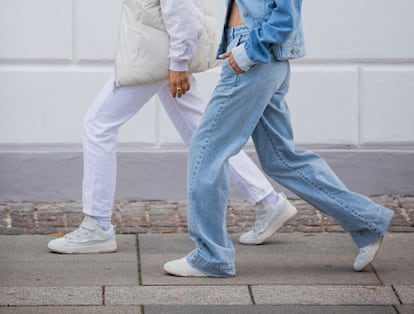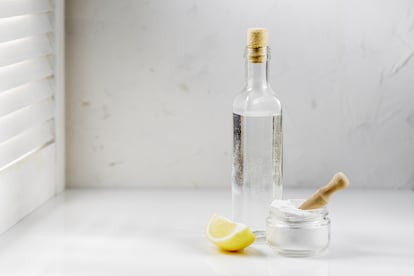White sneakers as good as new: A definitive guide to cleaning with vinegar
Safe, natural and effective, this ingredient has been passed from generation to generation as a favorite household trick. Now TikTok has crowned it the definitive anti-stain remedy

The acidic nature of vinegar is so powerful that it can dissolve mineral deposits, dirt and grease. It is also strong enough to kill bacteria. Its fame as a powerful cleaner has a long history. Passed from generation to generation, it is now the subject of countless TikTok and YouTube videos that are sharing the age-old tricks to cleaning sneakers of all kinds.
Vinegar’s cleaning power is enhanced by two elements: firstly, it is cheap and highly effective. Its most useful element is its acidity, around 5%, which makes it soft enough that it does not damage fabrics or surfaces (unlike bleach, which though a powerful disinfectant, is corrosive). Yet it is strong enough to eliminate stubborn stains and break down the structure of dirt, grease and bacteria. The acid breaks down stains, producing a salt called calcium acetate that is easily dissolved in water and carbon dioxide. Secondly, vinegar has antimicrobial properties. Some highly specialized bacteria can survive in acidic environments, but for most, it is difficult to resist and reproduce in such conditions.
Here we’ve gathered tips, tricks and cautionary tales to bring you the definitive guide to cleaning with vinegar.
1. For white sneakers
The most-searched cleaning tip on the internet consists of the following recipe: mix 1/4 cup of baking soda with two cups of white vinegar. Wait until the bubbles disappear. Then use a toothbrush to apply the mixture to the shoe. Let it sit for 15 to 20 minutes, then wash the shoes in the washing machine. Voilá!
For this trick, the shoes must be made from canvas (like Converse or Vans). For white leather sneakers, omit the washing machine step. Some hydrate the leather as they clean it with a mix of a quarter cup of vinegar with half a cup of olive oil in a spray bottle. (Shake the mixture continuously so that the ingredients do not separate.) Then the shoes are left to sit for five minutes, and the dirt is cleaned with a dry cloth, either microfiber or cotton, until they are clean and dry.

Vinegar, the current social media cleaning craze.
2. For baby onesies and children’s underwear
Parents of children in diapers know that in the first years of life, their clothes get stained a lot. The washing machine often is unable to eliminate the smells or the stains. Cleaning expert and columnist Jolie Kerr, known for Ask a Clean Person and the New York Times bestseller My Boyfriend Barfed in My Handbag…and Other Things You Can’t Ask Martha, suggests adding half a cup of white vinegar to the wash cycle — in the fabric softener compartment — to eliminate smells.
3. To remove smells from workout clothes
From Nike to Under Armor to Decathlon, if you check the tags of your T-shirt or leggings, manufacturers of sports garments specify that fabric softener should not be used to wash them. Despite going through the wash, the garments may retain a bad smell. Bacteria builds up in the fabric’s fibers. To eliminate the smell, turn the clothing inside out and wash it in cold water with half a dose of detergent and a cup of white vinegar. You may note a faint smell when you remove the garments from the wash, but as you air-dry them, it will dissipate.
4. To keep your towels like new
Advocates of this trick say that substituting fabric softener for vinegar will both enhance the smell of the detergent and make the towels fluffier. Remember, too, to wash new towels before using them for the first time, as both towels and bedclothes both may contain unwanted chemical compounds when they leave the factory.
5. To always have clean-smelling sheets
Asked how to keep sheets smelling good, but not reeking of perfumes, Jolie Kerr gives the following trick in the Washington Post: Use half a cup of white vinegar in the rinse cycle when you’re washing the clothes. It helps to eliminate odors and soften the fabric, and does not leave any odors behind.
6. To refresh your jeans
Since the head of Levi’s said he hadn’t washed his jeans in years — he just airs them out — the question of how to keep them clean and odorless, so that they last longer, has been a frequent topic of discussion on the internet. If you want to eliminate bad smells — of humidity or sweat, for example — vinegar can be a good ally. Use half a cup of white vinegar in the wash, along with the detergent. It will help to eliminate odors and also serves as a fabric softener.
7. To maintain a leather sofa
The vinegar solution can help to deodorize and clean large leather items. Mix equal parts of vinegar and water. In an article published in Esquire, Jolie Kerr recommends using a soft cloth, like an old cotton T-shirt or a microfiber cloth, dampened with the vinegar solution. Working in sections, go over the sofa with the solution, dipping it and wringing it out frequently, and following with a dry cloth. It is important for the liquid not to remain on the leather, because it could cause stains. When finished, apply a leather conditioner to keep the fabric moist and prevent the surface from drying out.
8. To deodorize a leather jacket
The principle is the same as the previous point, but with a slightly different technique: you can apply the vinegar and water formula with a spray. Remember that vinegar can dry out the leather, so it’s a good idea to apply a light layer of leather conditioner.
9. For the garments you forgot in the washer
It happens to all of us. You forget to remove the clothes after the wash cycle, and now they smell damp. There’s an easy solution: half a cup of vinegar.
10. For the kitchen, refrigerator and bathroom
Vinegar’s capacity to clean and eliminate smells is especially important when it comes to the kitchen and bathroom. It can be used to clean many things, including sinks and bathtubs, in addition to eliminating grease, hard water stains and soap scum. It can be used to clean counters (as long as they’re not made of natural stone or marble) and appliances that tend to retain smells. The New York Times recommends the following recipe to make your own homemade vinegar cleaner: half a cup of white vinegar, 500 milliliters of isopropyl alcohol, a teaspoon of dish soap and enough water to make four liters.
What you should never clean with vinegar
Just because it’s natural doesn’t mean vinegar is risk-free. There are some places where vinegar can cause more harm than good:
- The dishwasher. Vinegar can damage the rubber used on some parts of the dishwasher, such as the door seal.
- Stone or marble countertops. Vinegar can not only darken the surface, but also cause spills to penetrate into the stone and leave permanent stains and marks.
- The washing machine. Washing machines need to be cleaned without a load from time to time. But, as with the dishwasher, vinegar can damage the machine’s rubber seals and cause leaks.
- Screens. Vinegar is not a solution for cleaning a television, phone or tablet screen: it can damage their protective coverings. Use a microfiber cloth instead.
Why you should never mix vinegar with bleach
- While vinegar can be an excellent cleaning solution, you should never mix it with bleach. As TikToker Stephanie Booth explains in a bid, the mixture releases chlorine and chloramine gases, which can irritate the lungs and be potentially fatal. A good general rule is to never mix bleach with anything (except water).
Sign up for our weekly newsletter to get more English-language news coverage from EL PAÍS USA Edition
Tu suscripción se está usando en otro dispositivo
¿Quieres añadir otro usuario a tu suscripción?
Si continúas leyendo en este dispositivo, no se podrá leer en el otro.
FlechaTu suscripción se está usando en otro dispositivo y solo puedes acceder a EL PAÍS desde un dispositivo a la vez.
Si quieres compartir tu cuenta, cambia tu suscripción a la modalidad Premium, así podrás añadir otro usuario. Cada uno accederá con su propia cuenta de email, lo que os permitirá personalizar vuestra experiencia en EL PAÍS.
¿Tienes una suscripción de empresa? Accede aquí para contratar más cuentas.
En el caso de no saber quién está usando tu cuenta, te recomendamos cambiar tu contraseña aquí.
Si decides continuar compartiendo tu cuenta, este mensaje se mostrará en tu dispositivo y en el de la otra persona que está usando tu cuenta de forma indefinida, afectando a tu experiencia de lectura. Puedes consultar aquí los términos y condiciones de la suscripción digital.
More information
Últimas noticias
Petro claims the ELN was the target of US attack in Venezuela
Maduro counterattacks Trump with rhetoric and announces downing of nine drug trafficking aircraft
‘Ecce Homo’: The miraculous disaster that made a small Spanish town famous
Return to sex testing at the Olympics: IOC edges closer to banning transgender women
Most viewed
- Sinaloa Cartel war is taking its toll on Los Chapitos
- Oona Chaplin: ‘I told James Cameron that I was living in a treehouse and starting a permaculture project with a friend’
- Reinhard Genzel, Nobel laureate in physics: ‘One-minute videos will never give you the truth’
- Why the price of coffee has skyrocketed: from Brazilian plantations to specialty coffee houses
- Silver prices are going crazy: This is what’s fueling the rally










































